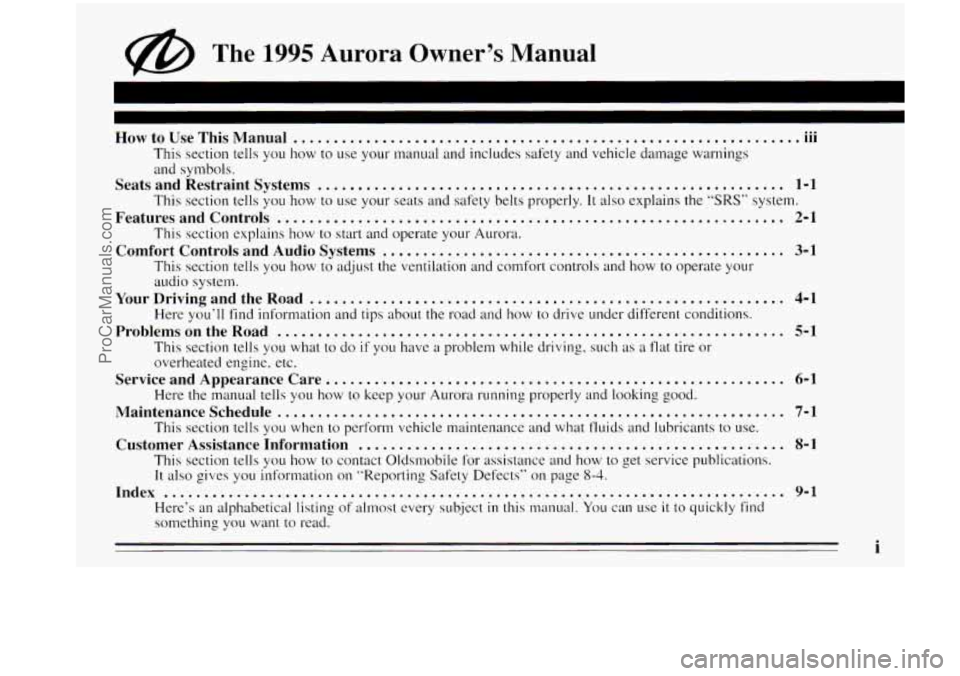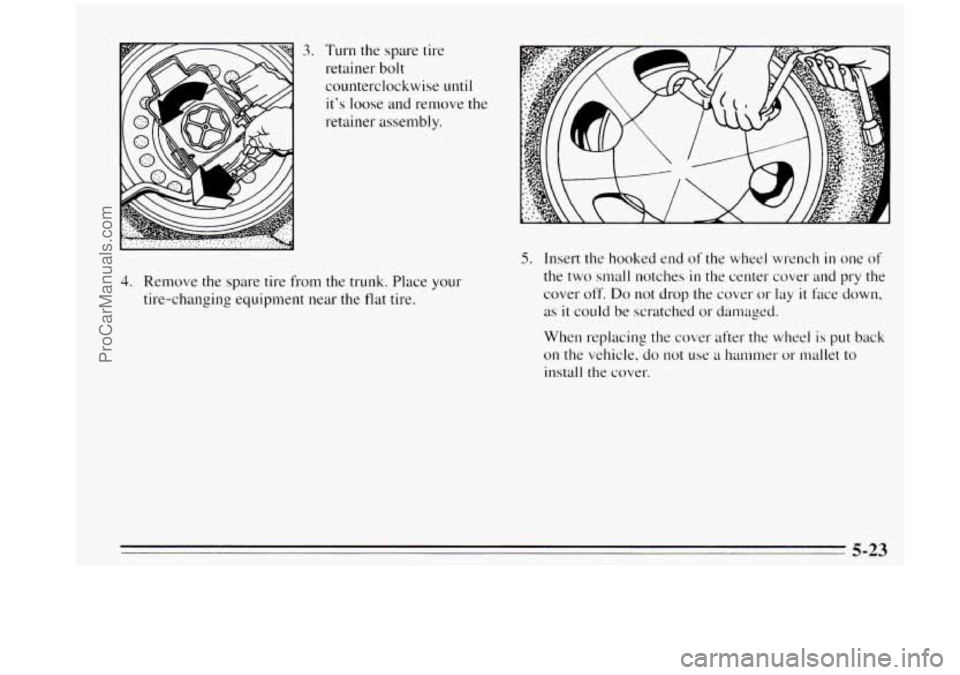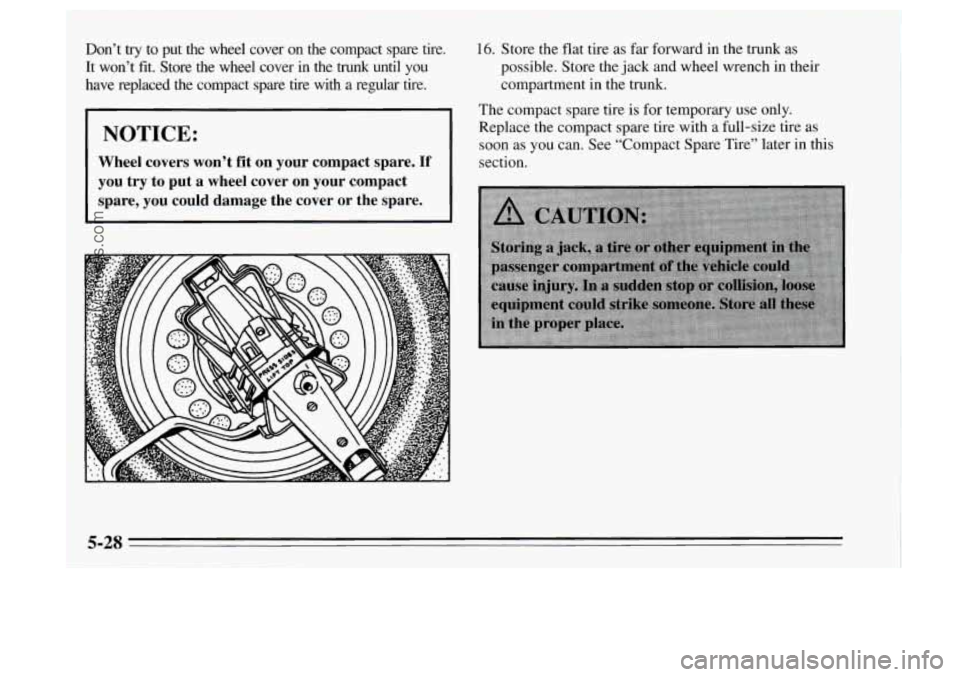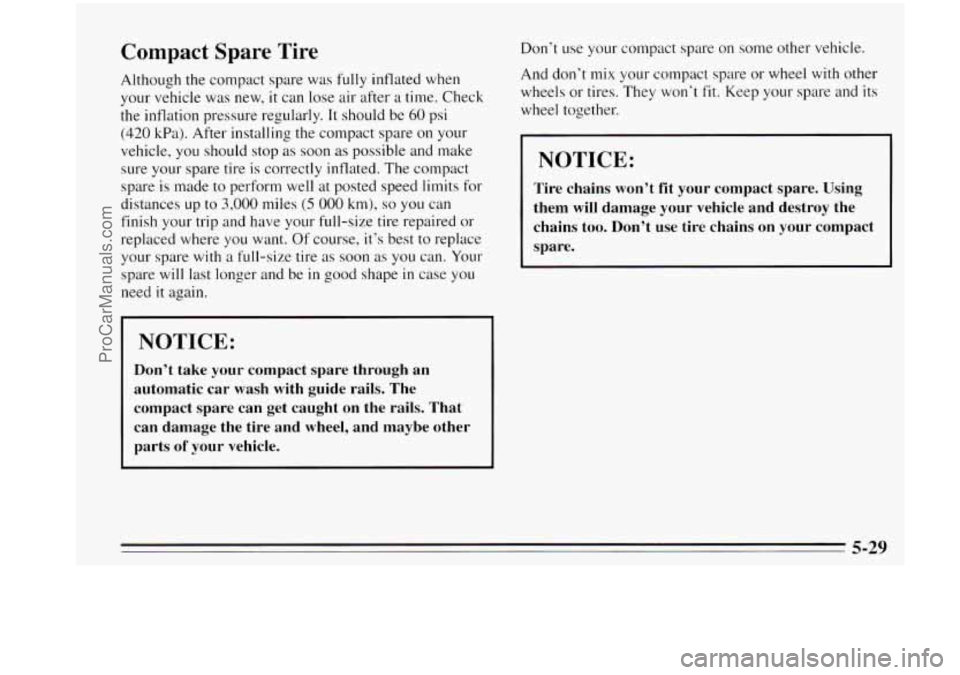flat tire OLDSMOBILE AURORA 1995 Owners Manual
[x] Cancel search | Manufacturer: OLDSMOBILE, Model Year: 1995, Model line: AURORA, Model: OLDSMOBILE AURORA 1995Pages: 372, PDF Size: 19.14 MB
Page 3 of 372

@ The 1995 Aurora Owner’s Manual
... How to Use This Manual .............................................................. .111
This section tells you how to use your manual at~d includes safct/ and vehicle damage warninls
and symbols.
This section tells you how
to use your seats and safcty belts properly. It also explains the “SRS” system.
This scction explains how to start and operate your Aurora.
This section tells you how to adjust the ventilation and comfort controls and how to operate your
audio system.
Here you‘ll I’ind information and tips about the road and how to drive under diffcrcnt conditions.
This section tells
you what to do if’ you ha\:e a problem while driving. such as B flat tire or
overheated enginc. etc.
ServiceandAppearanceCare ......................................................... 6-1
Here the ~nanual tells you how to keep your Aurora running properly and looking good.
Maintenanceschedule ............................................................... 7-1
This section tells you when to perform vehicle maintenance and what fluids and lubricants to use.
Customer Assistance Information ..................................................... 8-1
This section tells ~OLI how to contact Oldsmobile Uor assistance and how to get service publications.
It also gives you information on “Reporting Safety Defccts” on page 8-4.
Index ........................................................................\
..... 9-1
Hcrc‘s an alphabetical listing of almost every sub-ject in this manual. You can use it to quickly find
something yo11 want to read.
Seats and Restraint Systems .......................................................... 1-1
Features and Controls ............................................................... 2-1
Comfort Controls and Audio Systems .................................................. 3-1
Your Driving and the Road ........................................................... 4-1
ProblemsontheRoad ............................................................... 5-1
i
ProCarManuals.com
Page 185 of 372

Here are some things you can check before a trip:
0
0
0
0
0
0
0
Wi~~clsl~ield Wcuher F11,fid: Is the reservoir full? Are
all windows clean inside and outside?
Wiper Blcrdes: Are they in good shape?
Fuel, Engine Oil, Other. Fluicls: Have YOLI checked
all levels?
Lunlps: Are they all working? Are the lenses clean?
Tires: They are vitally important to a safe,
trouble-free trip.
Is the tread good enough for
long-distance driving? Are the tires all inflated to the
recommended pressure'?
Weatl?er Forecnsts: What's the weather outlook
along your route? Should
you delay your trip a short
time to avoid a major storm system?
Mcrps: Do you have up-to-date maps'?
Highway Hypnosis
Is there actually such a condition as "highway nypnosis"?
Or is
it just plain fdling asleep at the wheel? Call it
highway hypnosis, lack of awareness, or whatever.
There
is something about an easy stretch of road with
the same scenery, along with the
hum of the tires on the
road, the drone of the engine, and the rush of the wind
against the vehicle that can make you sleepy. Don't let it
happen to you!
If it does, your vehicle can leave the
road
in less tlml u second, and you could crash and be
injured.
What can you do about highway hypnosis? First, be
aware that
it can happen.
Then here are some tips:
0 Make sure your vehicle is well ventilated, with a
comfortably cool interior.
Keep your eyes moving. Scan the road ahead and to
the sides. Check your rearview mirrors and your
instruments frequently.
0 If you get sleepy, pull off the road into a rest, service,
or parking area and take
a nap, get some exercise, or
both. For safety, treat drowsiness on the highway as
an emergency.
4-21
ProCarManuals.com
Page 186 of 372

Hill and Mountain Roads
Driving on steep hills or mountains is different from
driving
in flat or rolling terrain.
If you drive regularly in steep country, or if you’re
planning to visit there, here are some tips that can make
your trips safer and more enjoyable.
Keep your vehicle in good shape. Check all fluid
levels and
also the brakes, tire.s, cooling system and
transaxle. These parts can work hard on mountain
roads.
Know how to go down hills. The most important
thing to know
is this: let your engine do some of the
slowing down. Shift to
a lower gear when you go
down a steep or long hill.
4-22
ProCarManuals.com
Page 192 of 372

Loading Your Vehicle
TIRE-LOADING INFORMATION
OCCUPANTS VEHICLE CAP. WT
FRT. CTR. RR. TOTAL
LBS. KG
MAX. LOADING & GVWR SAME AS VEHICLE
CAPACITY
WEIGHT XXX COLD TIRE
TIRE SIZE SPEED PRESSURE
RTG PSI;KPa
FRT.
RR.
SPA.
IF TIRES ARE HOT, ADD 4PSI.'28KPa
SEE OWNER'S MANUAL FOR ADDITIONAL
[ INFORMATION
Two labels on your vehicle show how much weight it
may properly carry. The Tire-Loading Information label
found on the rear edge of the driver's door tells
you the
proper size, speed rating and recommended inflation
pressure for the tires on your vehicle.
It also gives YOLI
important information about the number of people that
can be
in your vehicle and the total weight that you can
carry. This weight is called the Vehicle Capacity Weight
and includes the weight of
all occupants, cargo, and all
nonfactory-installed options.
MFD BY GENERAL MOTORS CORP
DATE GVWR GAWR
FRT GAWR RR
THIS VEHICLE CONFORMS TO ALL APPLI-
CABLE U.S. FEDERAL MOTOR VEHICLE
SAFETY, BUMPER, AND THEFT PREVENTION
STANDARDS IN EFFECT
ON THE DATE OF
MANUFACTURE SHOWN ABOVE.
The other label is the Certification label, found on the
rear edge of the driver's door.
It tells you the gross
weight capacity
of your vehicle, called the GVWR
(Gross Vehicle Weight Rating). The GVWR includes
the weight of the vehicle, all occupants, f~~el and cargo.
Never exceed the GVWR for your vehicle, or the Gross
Axle Weight Rating (GAWR) for either the
front of rear
axle.
And,
if you do have a heavy load, you should spread
it out. Don't carry more than I76 lbs. (80 kg) in your
trunk.
ProCarManuals.com
Page 196 of 372

Weight of the Trailer Tongue
The tongue load (A) of any trailer is an important
weight to measure because
it affects the total capacity
weight of your vehicle. The capacity weight includes the
curb weight of the vehicle, any cargo you may carry
in
it, and the people who will be riding in the vehicle. And
if you will tow a trailer, you must subtract the tongue
load from your vehicle’s capacity weight because your
vehicle will be carrying that weight, too. See “Loading
Your Vehicle”
in the Index for more information about
your vehicle’s maximum load capacity.
B A
If you’re using a “dead-weight” hitch, the trailer tongue
(A) should weigh 10% of the total loaded trailer weight
(B). If you have a “weight-distributing” hitch, the trailer
tongue
(A) should weigh 12% of the total loaded trailer
weight (B).
After you’ve loaded your trailer, weigh the trailer and
then the tongue, separately, to see
if the weights are
proper.
If they aren’t, YOLI may be able to get them right
simply by moving some items around
in the trailer.
Total Weight on Your Vehicle’s Tires
Be sure your vehicle’s tires are inflated to the
recommended pressure for cold tires. You’ll find these
numbers on the Certification label at the rear edge of the
driver’s door or see “Loading Your Vehicle”
in the
Index. Then be sure you don’t go over the
GVW limit
for your vehicle, including the weight of the trailer
tongue.
4-32
ProCarManuals.com
Page 221 of 372

If a Tire Goes Flat
It’s unusual for a tire to “blow out” while you’re driving.
especially
if you maintain your tires properly. If air goes
out of a tire, it‘s much more likely to leak out slowly.
But
if you should ever have a “blowout,” here are a few
tips about what to expect and what to do:
If a front tire fdils, the flat tire will create a drag that
pulls
the vehicle toward that side. Take your foot off the
accelerator pedal and grip the steering wheel firmly.
Steer to maintain lane position, then gently brake to a
stop well out
of the traffic lane.
A rear blowout, particularly on a curve, acts much like a
skid and may require the same correction you’d use in a
skid. In any rear blowout, remove your foot from the
accelerator pedal. Get the vehicle under control by
steering the way you want the vehicle to go.
It may be
very bumpy and noisy, but you can still steer. Gently
brake to a stop, well off the road
if possible.
If a tire goes flat, the next part shows how to use your
jacking equipment to change
a flat tire safely.
Changing a Flat Tire
If a tire goes flat, avoid further tire and wheel damage
by driving slowly to a level place. Turn on your hazard
warning flashers.
5-21
ProCarManuals.com
Page 223 of 372

3. Turn the spare tire
retainer bolt
counterclockwise
until
it’s loose and remove the
retainer assembly.
4. Remove the spare tire from the trunk. Place your
tire-changing equipment near the flat tire.
5. Insert the hooked end of the wlleel wrench in one of
the two small notches
in the center cover and pry the
cover off.
Do not drop the cover or lay it face down,
as
it could be scratched or damaged.
When replacing the cover after the wheel is
put back
on the vehicle, do not use a han~mer or mallet to
install the cover.
5-23
ProCarManuals.com
Page 226 of 372

I NOTICE:
Raising your vehicle with the jack improperly
positioned will damage the vehicle or may allow
the vehicle to fall off the jack. Be sure to fit the
jack lift head into the proper location before
raising your vehicle.
11. Remove all the wheel nuts and take off the flat tire.
/- 7--.. 12. Remove any rust or
dirt
from the wheel
bolts, mounting
surfaces and spare
wheel. Place the
spare on the wheel
mounting surface.
5-26
ProCarManuals.com
Page 228 of 372

Don’t try to put the wheel cover on the compact spare tire.
It won’t fit. Store the wheel cover
in the trunk until you
have replaced the compact spare tire with a regular tire.
NOTICE:
Wheel covers won’t fit on your compact spare. If
you try to put a wheel cover on your compact
spare, you could damage the cover or the
1 spare.
16. Store the flat tire as far forward in the trunk as
possible. Store the jack and wheel wrench in their
compartment in the trunk.
The compact spare tire is for temporary use only.
Replace the compact spare tire with a full-size tire as
soon as you can. See “Compact Spare Tire’’ later in this
section.
5-28
ProCarManuals.com
Page 229 of 372

Compact Spare Tire
Although the compact spare was fully inflated when
your vehicle
was new, it can lose air after a time. Check
the inflation pressure regularly.
It should be 60 psi
(420 kPa). After installing the compact spare on your
vehicle, you should stop
as soon as possible and make
sure your spare tire is correctly inflated. The compact
spare is made
to perform well at posted speed limits for
distances up to
3,000 miles (5 000 km), so you can
finish your trip and have your full-size tire repaired or
replaced where you want. Of course, it’s best
to replace
your spare with
a full-size tire as soon as you can. Your
spare will last longer and be in good shape in case you
need
it again.
NOTICE:
Don’t take your compact spare through an
automatic car wash with guide rails. The
compact spare can get caught on the rails. That
can damage the tire and wheel, and maybe other
parts
of your vehicle. Don‘t
use your compact spare
on some other vehicle.
And don’t mix your compact spare or wheel
with other
wheels or tires. They won’t fit. Keep your spare and its
wheel together.
I NOTICE:
Tire chains won’t fit your compact spare. Using
them will damage your vehicle and destroy the
chains too. Don’t use tire chains on your compact
spare.
5-29
ProCarManuals.com